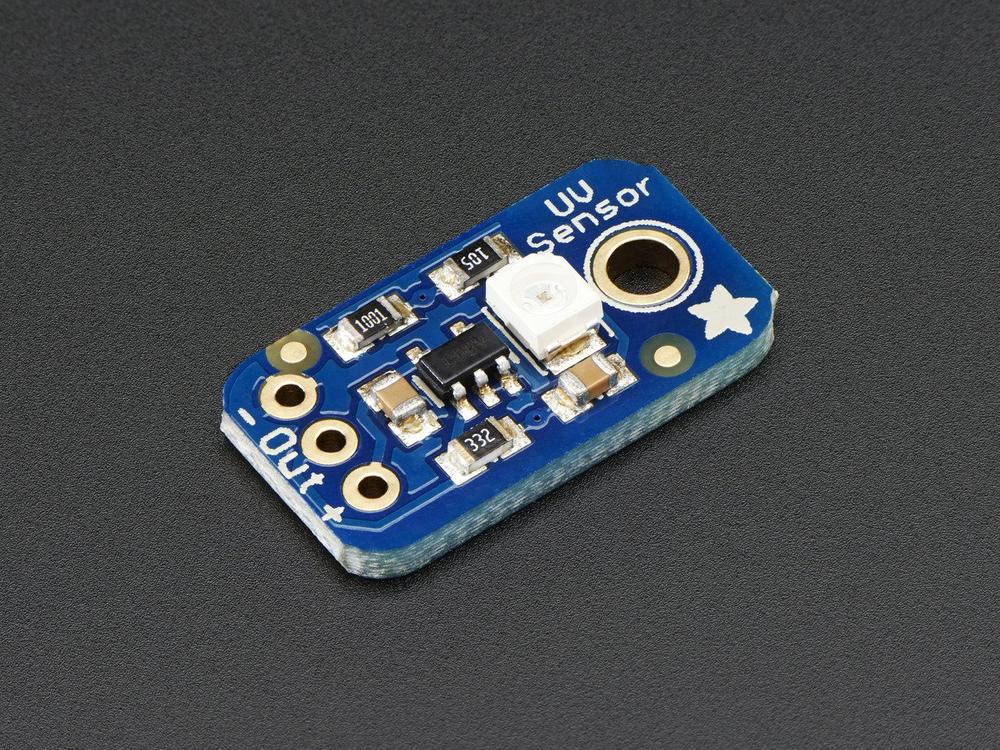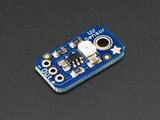Adafruit Analog UV Light Sensor Breakout - GUVA-S12SD

Description
Extend your light-sensing spectrum with this analog UV sensor module. It utilizes a UV photodiode capable of detecting the 240-370nm range of light, covering the UVB and most of the UVA spectrum. An integrated opamp amplifies the minimal signal from the photodiode to a more manageable voltage level.
This sensor offers straightforward functionality with an analog voltage output, devoid of the complexities of an I2C setup. Ideal for uncomplicated projects, it features a true UV sensor rather than a calibrated light sensor.
Power the sensor and op-amp by connecting the V+ to 2.7-5.5VDC and GND to power ground. Read the analog output signal from the OUT pin. The output voltage formula is: Vo = 4.3 * Diode-Current-in-uA, meaning a 1uA photocurrent yields a 4.3V output. Convert this to a UV Index by dividing the voltage by 0.1V.
For effective testing, avoid using UV LEDs at 400nm, as they fall outside the sensor's range. Instead, opt for a UV tanning lamp or lizard-lamp for accurate measurements.
Properties
| Brand | Adafruit |
| Model | 1918 |
Alternative products
- In stock DFRobot Gravity: UV Index Sensor (240-370nm, UVA, UVB, UVC) € 8,30 View product
- SparkFun Mini Spectral UV Sensor - AS7331 (Qwiic) € 33,70 View product
- Adafruit VEML6070 UV Index Sensor Breakout € 6,20 View product
- DFRobot Gravity: Analog UV Sensor (ML8511) € 10,35 View product
- Adafruit Flora UV Index Sensor - Si1145 Light Sensor € 9,30 View product
- Adafruit SI1145 Digital UV Index / IR / Visible Light Sensor € 10,35 View product
- DFRobot Gravity: Analog UV Sensor V2 € 6,20 View product
- SparkFun Spectral UV Sensor - AS7331 (Qwiic) € 28,35 View product
- In stock Opencircuit BH1750FVI digital light sensor module (GY-302) € 1,95 View product
- Adafruit VCNL4010 Proximity/Light sensor € 7,85 View product
- DFRobot Gravity: VEML6075 UV Sensor Module € 7,05 View product
Customer questions
 Louis De CosterHow much measuring load can this sensor handle? How much current can the unit deliver without affecting the measurement?
Louis De CosterHow much measuring load can this sensor handle? How much current can the unit deliver without affecting the measurement? Customer Reviews
 Sef Konings
Sef Konings Sef Konings
Sef KoningsSuggested products
- In stock Opencircuit 6-DOF (gyroscope and accelerometer) module (GY-521) € 2,80 View product
- In stock Opencircuit Infrared receiver and remote control kit € 2,65 View product
- In stock Opencircuit HC-SR04 Ultrasonic distance detection module € 1,75 View product
- In stock Opencircuit PIR motion detection module € 1,55 View product
- Opencircuit Breadboard white 400 points € 1,75 View product
- In stock Opencircuit Sound detection sensor module € 1,45 View product
- 5 pieces In stock Opencircuit Passive 5V buzzer - 5 pcs € 2,30 View product
- In stock Opencircuit DHT22 Humidity and temperature sensor € 6,20 View product
- Opencircuit Tansparant frame for the W1209 temperature-controlled relay € 1,25 View product
- Adafruit RGB Color Sensor with IR filter and White LED - TCS34725 € 8,30 View product
- In stock Adafruit MCP9808 High Accuracy I2C Temperature Sensor Breakout Board € 5,20 View product
- Adafruit ADXL335 - 5V ready triple-axis accelerometer (+-3g analog out) € 15,30 View product
- Opencircuit Gift card View product
- In stock Cytron Maker Mini Sumo Controller: Simplifying Sumo Robot for Beginner € 33,45 View product
- In stock Itead SONOFF Zigbee Motion Sensor | SNZB-03P € 12,60 View product
- In stock Adafruit White LED Backlight Module - Medium 23mm x 75mm € 2,70 View product
- In stock Adafruit NOOds - Flexible LED Filament - 3V 300mm long - Red € 7,85 View product
- 3 pieces In stock Adafruit LED Filament - 3V 26mm long - Warm White 3 Pack € 4,75 View product
- In stock Adafruit Breadboard-friendly 2.1mm DC barrel jack € 1,05 View product
- In stock Adafruit I2S 3W Class D Amplifier Breakout - MAX98357A € 6,20 View product
- In stock Adafruit IR Break Beam Sensors with Premium Wire Header Ends - 3mm LEDs € 3,10 View product
- In stock Adafruit Pressure-Sensitive Conductive Sheet (Velostat/Linqstat) € 5,20 View product
- In stock Adafruit IR Break Beam Sensor with Premium Wire Header Ends - 5mm LEDs € 6,20 View product
- In stock Adafruit Woven Conductive Fabric - 20cm square € 5,20 View product
- 5 pieces In stock Adafruit NeoPixel Diffused 5mm Through-Hole LED - 5 Pack € 5,20 View product
- In stock Adafruit Stereo Enclosed Speaker Set - 3W 4 Ohm € 7,85 View product
- In stock Adafruit NOOds - Flexible LED Filament - 3V 300mm long - Blue € 7,85 View product
- In stock Adafruit NOOds - Flexible LED Filament - 3V 300mm long - Lime Green € 7,25 View product
- In stock Adafruit Small Enclosed Piezo w/Wires € 1,05 View product
- In stock Adafruit Bone Conductor Transducer with Wires - 8 Ohm 1 Watt € 9,30 View product
Recently viewed items
- In stock Adafruit Analog UV Light Sensor Breakout - GUVA-S12SD € 6,85 View product
- 25 pieces Sparkfun LED - Red with Resistor 5mm (25 pack) € 12,85 View product
- Velleman IR light barrier burglar alarm - kit € 8,85 View product
- In stock Apollo Automation Apollo PLT-1 Ultimate Plant Sensor For Home Assistant - battery version € 40,15 View product
- Waveshare ISX031 3MP GMSL Camera Module, IP67 Protection Degree, More Durable € 508,30 View product








